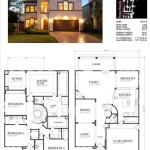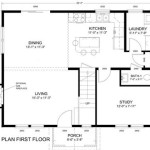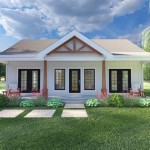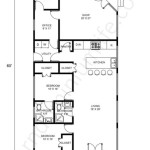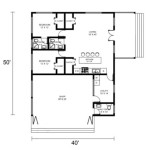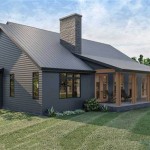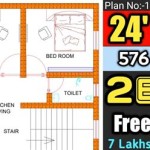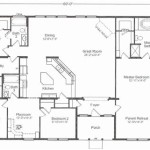4 Bedroom Log Home Plans: Maximizing Space and Rustic Charm
Log homes evoke a sense of natural beauty, durability, and connection to the environment. Choosing a 4-bedroom log home plan offers the opportunity to combine this rustic aesthetic with the practical needs of a growing family or those who desire ample space for hosting guests. Careful consideration of design elements, layout, and construction techniques is crucial to ensuring a comfortable and functional living environment within the log home structure.
The appeal of log homes extends beyond their visual charm. They are known for their energy efficiency, thanks to the natural insulation properties of wood. Furthermore, log homes can be incredibly durable, capable of withstanding severe weather conditions when properly constructed and maintained. The process of selecting a 4-bedroom log home plan involves considerations that range from the size and orientation of the lot to the specific lifestyle requirements of the occupants. This article explores key aspects of 4-bedroom log home plans, highlighting important factors to consider during the planning and construction phases.
Understanding Space Allocation and Layout
Designing a 4-bedroom log home requires careful planning of space allocation and layout. The internal arrangement should facilitate comfortable living while maximizing the use of the available square footage. An effective layout will consider the flow between different areas, ensuring smooth transitions between living spaces, bedrooms, and utility areas.
The primary living area, typically incorporating the living room, dining room, and kitchen, should be centrally located and designed to promote social interaction. Open-concept designs are popular in log homes, as they amplify the feeling of spaciousness and allow natural light to penetrate deeper into the structure. Thoughtful placement of windows and doors is critical to optimizing natural light and ventilation throughout the home.
Bedroom placement is also a key consideration. Ideally, the master suite should be separated from the other bedrooms to provide privacy and a sense of seclusion. The master suite typically includes a generously sized bedroom, a walk-in closet, and a private bathroom. The remaining three bedrooms can be arranged to suit the specific needs of the family, such as pairing two bedrooms with a shared bathroom or allocating each bedroom with its own en-suite bathroom. The placement of bedrooms relative to common areas can impact noise levels and privacy, which should be factored into the design. Hallways should be wide enough to accommodate furniture movement and minimize congestion.
Utility spaces, such as laundry rooms, mudrooms, and storage areas, should be strategically placed to provide convenience without detracting from the overall aesthetic appeal of the home. The laundry room should be located near the bedrooms, ideally on the same level, to minimize the effort required for laundry management. Mudrooms, often positioned near entryways, provide a space to remove and store outdoor gear, preventing dirt and debris from being tracked into the main living areas. Sufficient storage space, strategically located throughout the home, is essential for maintaining an organized and clutter-free living environment.
The orientation of the home on the lot is also a critical factor in space allocation. Taking advantage of natural sunlight can reduce heating costs in the winter and provide ample lighting throughout the year. The prevailing winds should also be considered to maximize natural ventilation and minimize the impact of severe weather. This site-specific optimization can significantly contribute to the long-term comfort and energy efficiency of the log home.
Key Design Considerations for 4-Bedroom Log Homes
Beyond the basic layout, several design considerations are crucial to creating a functional and aesthetically pleasing 4-bedroom log home. These considerations encompass structural aspects, interior design elements, and exterior features that contribute to the overall character and usability of the home.
The choice of log type and construction method is fundamental to the structural integrity and visual appeal of the home. Common log types include round logs, square logs, and D-shaped logs, each offering a distinct aesthetic and construction characteristics. The chinking method, which involves filling the gaps between the logs, also affects the appearance and energy efficiency of the home. Proper chinking is essential for preventing air and water infiltration, thus ensuring a comfortable and energy-efficient living environment.
Roof design is another important consideration. Gable roofs, shed roofs, and hip roofs are common choices for log homes, each offering different aesthetic and structural advantages. The roof pitch should be optimized for snow load in areas with heavy snowfall, while also considering the overall architectural style of the home. Overhangs should be designed to protect the logs from excessive exposure to the elements, extending their lifespan and reducing the need for maintenance.
Interior design elements contribute significantly to the overall ambiance of the home. Incorporating natural materials, such as wood flooring, stone fireplaces, and exposed beams, can enhance the rustic character of the log home. The color palette should complement the natural tones of the logs, creating a cohesive and inviting atmosphere. Proper lighting is essential for highlighting the architectural features of the home and creating a comfortable and functional living environment. A combination of natural light, ambient lighting, task lighting, and accent lighting can be used to achieve the desired effect.
Exterior features, such as porches, decks, and landscaping, can extend the living space and enhance the outdoor appeal of the home. Porches provide a covered area for relaxation and outdoor entertaining, while decks offer a space for sunbathing and enjoying the surrounding scenery. Landscaping should complement the natural setting of the home, creating a harmonious and visually appealing environment. Native plants and natural materials can be used to create a low-maintenance and environmentally friendly landscape.
Maximizing Energy Efficiency in Log Homes
Energy efficiency is a major advantage of log homes, but achieving optimal performance requires careful attention to design and construction details. Proper insulation, airtight construction, and efficient heating and cooling systems are essential for minimizing energy consumption and reducing utility bills.
The natural insulation properties of logs contribute to the energy efficiency of the home, but additional insulation may be required in colder climates. Insulation can be added to the roof, walls, and foundation to further reduce heat loss. Spray foam insulation, fiberglass batts, and rigid foam boards are common insulation materials used in log homes. Properly insulating the home can significantly reduce heating and cooling costs, creating a more comfortable and sustainable living environment.
Airtight construction is crucial for preventing air leaks and drafts, which can significantly impact energy efficiency. Proper sealing of windows, doors, and other openings is essential for minimizing air infiltration. Caulking, weather stripping, and spray foam can be used to seal gaps and cracks, creating a tighter building envelope. Regular inspections and maintenance can help identify and address any air leaks that may develop over time.
Efficient heating and cooling systems can further reduce energy consumption. High-efficiency furnaces, air conditioners, and heat pumps can significantly lower utility bills compared to older, less efficient models. Programmable thermostats can be used to automatically adjust the temperature based on occupancy patterns, further reducing energy consumption. Radiant floor heating is a popular option for log homes, as it provides even and comfortable heating throughout the home.
Renewable energy sources, such as solar panels and geothermal systems, can also be incorporated into the design to further enhance energy efficiency. Solar panels can generate electricity, reducing reliance on the grid, while geothermal systems can provide heating and cooling using the earth's natural temperature. These renewable energy sources can significantly reduce the environmental impact of the home and lower long-term operating costs.
Window selection plays a crucial role in energy efficiency. Energy-efficient windows with low-E coatings and multiple panes can reduce heat transfer and prevent drafts. The U-factor and solar heat gain coefficient (SHGC) are important metrics to consider when selecting windows for a log home. The U-factor measures the rate of heat transfer through the window, while the SHGC measures the amount of solar heat that passes through the window. Windows with lower U-factors and SHGCs are generally more energy-efficient.
Proper ventilation is also essential for maintaining indoor air quality and preventing moisture buildup. Mechanical ventilation systems, such as heat recovery ventilators (HRVs) and energy recovery ventilators (ERVs), can provide a constant supply of fresh air while minimizing heat loss. These systems exchange stale indoor air with fresh outdoor air, removing pollutants and moisture while recovering heat energy. Proper ventilation can help prevent mold growth and improve indoor air quality, creating a healthier living environment.

Best 4 Bedroom Log Cabin House Plans Home Floor

Browse Floor Plans For Our Custom Log Cabin Homes House Home

Log Home Floor Plans Four Bedroom

Log Cabin Home 4 Bdrm 5 Bath 4565 Sq Ft Plan 132 1291

Log Home Floor Plans Four Bedroom

Log Cabin Floor Plans Many To Choose From

No Hay Texto Alternativo Automático Disponible Craftsman House Plans Lake Log Home Floor
Log Cabin Home 4 Bdrm 2 Bath 2911 Sq Ft Plan 132 1217

Custom Log Home Floor Plans Katahdin Homes

Log Home Floor Plans Four Bedroom

